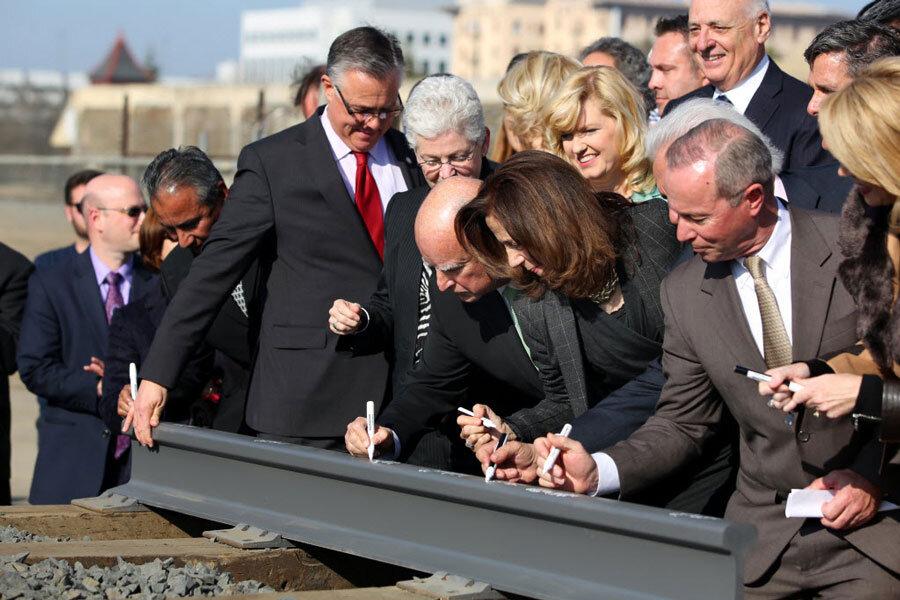California high-speed rail: why big-vision projects struggle today
| Los Angeles
One of the biggest transportation projects in US history broke ground this week in California – six years after voters first approved $10 billion in bonds to fund it and at a much-higher projected cost than originally estimated.
Gov. Jerry Brown’s efforts, in the face of vociferous criticism, to build a high-speed rail in car-centric California can be seen as a parable for the struggles that beset many big-vision – and big-ticket – projects attempted in America today.
The biggest challenge with major public works projects, experts say, is just how many unknowns are involved, from who will pick up the tab for budget overruns to who is going to actually use the system and how they will use it. That’s coupled with state and federal coffers that have seen several lean years, as well as legislators who recently have found it more practical, or more politically expedient, to just say no.
Times certainly have changed when it comes to moving major public works from idea to reality, says Matthew Hale, associate professor of public administration as well as political science at Seton Hall University.
He points out that when Governor Brown’s father, Pat, was governor of California, he was able to “herd the legislative house cats into building massive infrastructure projects.”
The problem today, Professor Hale notes via e-mail, is that the legislative cats Governor Brown faces “are wild and feral, not house cats.”
It is much easier for legislators to be independent of the governor today and that makes building big infrastructure projects much more difficult, he says.
There are also concerns that the project – currently projected to cost $68 billion – may wind up costing even more by the time the last mile of rail is laid. So far, voters have approved $10 billion in bonds, and the federal government is contributing $3.3 billion to the project – leaving $55 billion that still needs funding to get the 520-mile project up and running by 2030.
“When you do these really big projects, they almost always come in way, way over budget,” says Robert Atkinson, president of the Information Technology and Innovation Foundation in Washington. Plus, he adds, “There is much more competition for money these days, which makes it much harder to approve really big projects.”
Boston’s Big Dig, for example, which buried the city’s Central Artery underground and opened up the core of the city to pedestrians, had a final price tag of $24.3 billion (including interest). That was up from an original estimate of $2.6 billion – making it the most expensive highway project in US history.
“Big visions are a problem…especially because there won’t be many more that come with unfunded mandates,” says Barbara O’Connor, director emeritus of the Institute for Study of Politics and Media at California State University in Sacramento. “Big visions need to be clear and executable or they will not pick up followers.”
“Whether this is a good, big-vision project or a boondoggle may depend on who you are talking to,” says Professor O’Connor.
For his part, Governor Brown was quick to brush aside the chorus of critics – a number of whom showed up to protest at the ground-breaking in Fresno Tuesday for the first 29 miles of the project. Naysayers, he claimed, are to be expected whenever someone proposes big-vision public works.
“Everything big runs into opposition,” Brown said in his remarks Tuesday, pointing to such public works as the California Water Project, the Golden Gate Bridge, and BART (Bay Area Rapid Transit).
“People do get pusillanimous. That’s the adjective I’m going to affix to all the critics. … It means weak of spirit,” he added.
But some question whether the needs of California residents, or Governor Brown’s legacy, are propelling the project forward.
“This is a sexy legacy project,” says Michael Shires, professor of public policy at Pepperdine University.
“But the real question is does the region really need this?” he says, noting that there is not a demonstrated need for more transportation capacity between south and north California.
For instance, he says, there is already talk of closing two regional airports in southern California due to a lack of traffic.
Beyond that, says Professor Shires, California does not have a strong rail culture, “so you are talking about not just lack of demonstrated need, but also changing a car culture.”
Another difficulty, says Hale, is that there are simply more people in the way.
Back when Pat Brown was governor, he didn’t have as many local jurisdictions that actually had people living in them, so putting in a new university or freeway required less negotiating.
For example, he says, “When Pat Brown wanted to build UC Irvine, all he had to do was talk with a handful of orange growers and ranchers. Every inch of bullet train track will have local interests that will want a say in the matter.”






